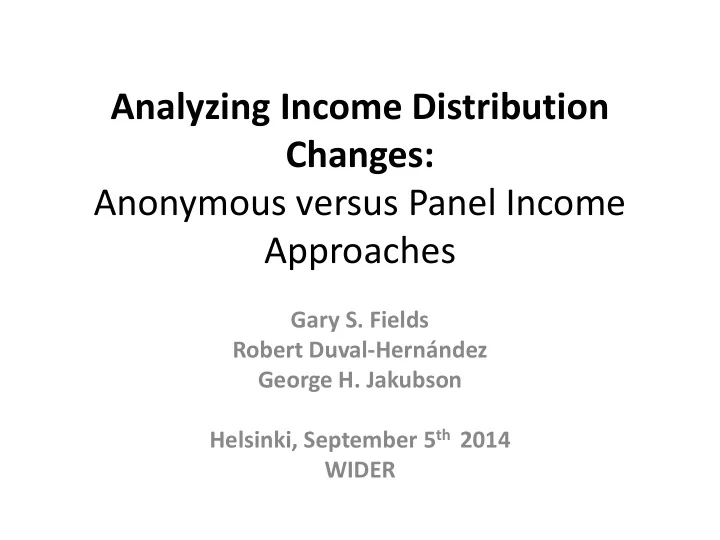

Analyzing Income Distribution Changes: Anonymous versus Panel Income Approaches Gary S. Fields Robert Duval-Hernández George H. Jakubson Helsinki, September 5 th 2014 WIDER
Main Questions • Who gains and who is hurt when the distribution of income changes? – Anonymous vs panel income approaches • How our view of inequality is altered if we focus on the inequality of average income? – What factors account for equalization /disequalization of longer-term incomes that occurs as a result of economic mobility
The Two Basic Concepts and Their Measures X-sectional Changes in Inequality Convergent/Divergent Anonymous Approach Panel Income Changes Δ𝑧 = 𝛿 𝑧 + 𝜀 𝑧 𝑧 0 + 𝑣 𝑧 • Lorenz Criteria • Lorenz-consistent Inequality Indices where y can be • Lorenz-inconsistent • Dollars Inequality Indices • Income shares • Log-dollars. Alternatively, 𝑒 1 − 𝑒 0 = 𝜚 + 𝜄𝑒 0 + 𝑣 𝑞𝑞𝑞 . 𝑒 0
Reconciliation In Duval, Fields, and Jakubson (2014) we show in detail how it is theoretically possible to have: Rising Falling Inequality Inequality √ √ Convergent Panel Income Changes √ √ Divergent Panel Income Changes
Reconciling: Rising Inequality and Convergent Income Changes Simultaneously: a) Anonymous rich and poor getting farther apart b) Initial poor are getting closer to the initial rich. Hence, reconciliation is only possible if initial rich/poor are not the same people as anonymous rich/poor.
Reconciling: Rising Inequality and Convergent Income Changes (cont.) e.g. 𝑧 0 = [20, 41, 45, 49, 70] becomes 𝑧 1 = 100, 41, 45, 49, 10 Key ingredient: Large income changes that generate crossings among individuals.
Reconciling: Falling Inequality and Divergent Income Changes Impossibilities: – Log divergence cannot lead to falling Log-Variance (Furceri 05, Wodon & Yitzhaki 06). – Divergence in: • Shares • Exact proportional changes • Dollars/€ in Recession Years cannot lead to Lorenz-Improvement.
Reconciling: Falling Inequality and Divergent Income Changes (cont.) Any other combination of: – Falling Inequality – Divergent income changes is possible, e.g. • [5, 20]→[7,23 ] (divergent dollar changes & LI) • [1,1,1,1,1,1,1,1,6,9]→ [1,1,1,1,1,1,1,1,7,8 ] (divergent log-dollar changes & LI).
Empirical Reconciliation for Mexico • Labor Survey in Urban Mexico 1987 - 2013. • Monthly Earnings in 2010 Mx Pesos • Labor force participants (including unemployed) • 18 to 65 years of age • Individuals are followed for 5 quarters • Many short-lived rotational panels
Convergence Coefficient δ Inequality (for regression in Mx pesos) .5 9 0.55 8 0 var log 0.50 coefficient gini 7 -.5 0.45 6 5 -1 1990q1 1995q1 2000q1 2005q1 2010q1 2015q1 1990 1995 2000 2005 2010 Coef. c.i. 95% Gini Var logs
Final Earnings (000s) Initial Earnings (000s) [0,1) [1,2) [2,3) [3,4) [4,5) [5,6) [6,7) [7,8) [8,) Total [0,1) 3.7 0.9 1.1 1.8 0.8 0.7 0.2 0.0 0.3 9.7 [1,2) 0.9 1.3 0.9 0.8 0.5 0.2 0.0 0.0 0.2 4.7 [2,3) 0.6 0.8 1.5 2.6 1.1 0.5 0.2 0.3 0.3 7.9 [3,4) 1.1 0.4 4.2 10.5 4.5 3.0 1.1 0.6 1.3 26.9 [4,5) 0.3 0.2 0.7 8.0 5.1 1.7 0.9 0.4 1.6 18.9 [5,6) 0.2 0.0 0.4 2.4 2.2 1.4 0.9 0.8 1.3 9.6 [6,7) 0.2 0.1 0.1 1.1 0.7 1.2 0.8 0.5 1.2 5.9 [7,8) 0.1 0.0 0.1 0.6 0.4 1.0 0.4 0.6 1.5 4.7 [8,) 0.2 0.1 0.1 0.5 0.6 0.9 1.1 0.9 7.3 11.7 Total 7.4 3.8 9.1 28.4 15.9 10.6 5.7 4.0 15.1 100 The cells are % of the sample population. The data corresponds to the panel ENEU q3-1987 to q3-1988.
Densities of Final Log-Earnings and Log-Earnings Changes by Quartile Group of Initial Earnings. Employed Workers Only
How Does Mobility affect Inequality of Average Income Compare inequality of initial income, 𝐽 𝑧 0 vs inequality of average income 𝐽 𝑧 𝑏 , 𝐹𝐹𝐹 = 𝐽 𝑧 0 − 𝐽 𝑧 𝑏 Use Fields 03/ Yun 06 decomposition to: • Examine what observable factors account for this equalization • Decompose contribution of changing: – Observable characteristics – Coefficients
Equalizing Mobility Gap Gini Variance of Log-Earnings
Accounting for Equalization of Average Earnings due to Mobility Non-recession Recession 2.16 (100) 1.73 (100) V(ln y 0 ) - V(ln y a ) Chars Coeff Chars Coeff Gender 0.002 0.003 0.005 -0.001 (0.1) (0.2) (0.3) -(0.1) Age 0.005 0.014 0.004 0.014 (0.3) (0.7) (0.2) (0.8) Education -0.001 0.008 -0.001 0.016 -(0.1) (0.4) -(0.1) (0.9) Unemployment 1.503 0.002 1.164 0.020 (69.7) (0.1) (67.2) (1.1) Informality -0.005 -0.051 0.008 -0.061 -(0.2) -(2.4) (0.4) -(3.5) Occupation 0.024 -0.018 0.024 -0.027 (1.1) -(0.8) (1.4) -(1.5) Industry -0.027 -0.005 -0.019 -0.009 -(1.3) -(0.2) -(1.1) -(0.5) City dummies 1.88E-05 0.003 -2.91E-05 0.002 (0.001) (0.1) -(0.002) (0.1) Period dummies 0.002 0.001 0.002 -0.003 (0.1) (0.03) (0.1) -(0.2) Residuals 0.696 0.596 (32.3) (34.4) ln y 0 denotes initial log-earnings, ln y a denotes average log earnings. Percentage Shares of V(ln y 0 ) - V(ln y a ) are reported in parentheses. Char and Coeff are, respectively, characteristics and coefficients effects.
Conclusions • Anonymous vs Panel approaches lead to very different answers for gauging income changes • Both are meaningful, albeit different. • Intuitive way to account for the factors that equalize average earnings (relative to initial) – Significant role of job transitions in equalizing and disequalizing average relative to initial earnings.
Recommend
More recommend